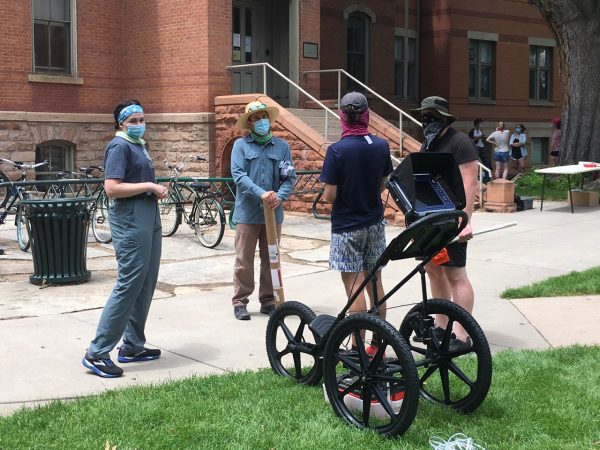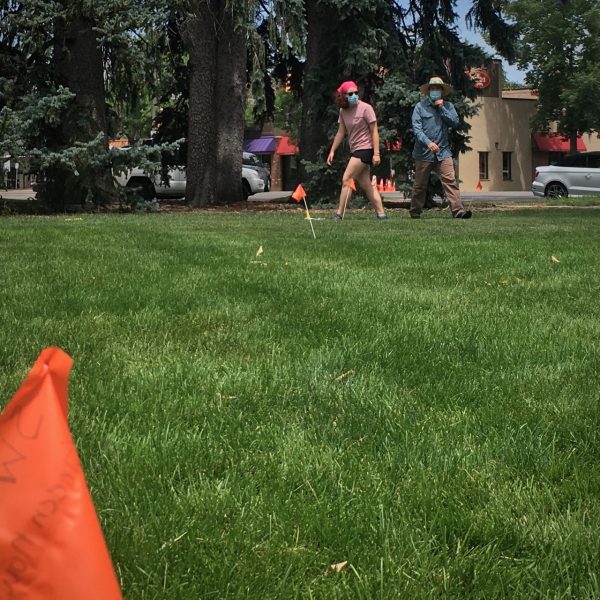Archaeology Field School breaking all sorts of ground this summer
Joshua Zaffos
While the Coronavirus has closed and quieted universities across the country this year, a small but historic piece of Colorado State University campus is buzzing with the sounds of students – and shovels – this summer. The CSU Archaeology Field School, celebrating its 51st year as the cornerstone experiential program of the Department of Anthropology and Geography, is one of a limited number of field schools taking place – in the actual field – this year.

“We are very proud of the work we’ve done to meet safety requirements yet deliver an impactful and applied learning experience for our students, said Dr. Edward Henry, assistant professor of anthropology and this year’s field school director. “And the main project is an especially relevant one for CSU and the region.”
All program participants are using masks in the field, receiving daily temperature scans, taking regular water and rest breaks, and following other COVID-19 health and safety protocols during workdays and outside of class, too. Following a first week of online instruction of field techniques and project details, the group of eleven students plus faculty stepped onto the sunny campus lawns in early July, with plans to excavate through the rest of the month.
By eliminating the need for shared housing and extended travel to a study site, “we’re in a unique position,” said Henry. “This does allow us to create one model for doing fieldwork going forward during the pandemic.”
The Archaeology Field School, which has been running since 1969, trains a small group of students each summer in archeological techniques and practices, including surveying methods, excavation strategies, and cultural resources management. Over the years, the field school has worked around Colorado and beyond, including ancient Indigenous sites and abandoned settler communities. Students earn eight credits through the experience and gain valuable field and tech experience.
This year’s fieldwork was set to take place in Tennessee’s Pinson Mounds State Archaeological Park. But as COVID-19 scuttled that arrangement, Henry adjusted his plans and moved the field school to campus to reduce travel.


“Knowing that a handful of field-school students needed these credits to finish their undergrad careers and get their diplomas in hand this summer was a driving reason to push to make this field school happen during the pandemic,” said Henry. “I really wanted to make sure nobody had to hold off an extra semester or potentially another academic year to finish their degrees.”
As it turned out, Henry and CSU were ready with an interesting project to uncover the university’s origins.
Over the course of six weeks this summer, the field school will be conducting geophysical surveys and excavating the “claim building,” a modest structure near the intersection of South College Avenue and Laurel Street, which was the first building constructed on what would eventually become CSU. Built in 1874, the exact physical location of this important campus structure has been lost to history, but geophysical mapping of the site suggests features likely remain that could provide insight into how the building was used.
Henry, who leads the Center for Research in Archaeogeophysics and Geoarchaeology at CSU, and colleague Dr. Mary Van Buren are using this project to examine the material culture of CSU’s early institutional history. Graduate student Carly DeSanto is also taking part in the research and serving as a teaching assistant for the field school.
Overall, Henry is excited to examine how the building’s construction served to “claim” the physical space for a campus as well as claim land-grant status for the institution in anticipation of Colorado statehood which came three years later. Without the claim building, CSU might be in another Colorado city and Fort Collins would look very different. Unearthing the claim building is also an opportunity to acknowledge the Indigenous people and tribes that formerly lived on and used the lands that now make up campus – and how it came to be that the land was available to be “claimed.”
The project and findings will enable CSU to rediscover a key piece of its origins as the university celebrates its 150th anniversary. Perhaps most importantly, it is also giving students a much-desired opportunity for field learning and face-to-face interactions with peers and professors after the academic year was cut short.

After wondering whether the field school would even happen, “I was so relieved when that email came through to say, ‘You’re going!’” said Devan Green, a senior and Anthropology major with an Archaeology concentration from Brighton, Colorado. “We’ve read about all these toys and gadgets and technology in class but I’ve never seen them in action and used them.”
“Being part of one of the first classes and only field schools going on right now feels pretty special,” said Bobbie Abeyta, senior and Anthropology major with an Archaeology concentration. “Definitely feeling blessed to be out in the field every day.”
“We know students are craving face-to-face learning experiences, and that the move to online teaching is not how any residential student imagines their undergraduate experience to unfold,” said Dr. Mica Glantz, Anthropology and Geography department chair and professor. “We are so happy to bring back a little bit of normal for our students, and to engage them with all senses – even with masks on and hand sanitizer at the ready! We are anthropologists, we adapt!”
***
The field school will hold “public days” on the last three Fridays in July (July 17, 24, and 31) when visitors can tour the site by appointment. To schedule a visit, please contact Josh Zaffos, communications specialist, Department of Anthropology and Geography: 970/443.4747 (mobile) or joshua.zaffos@colostate.edu.